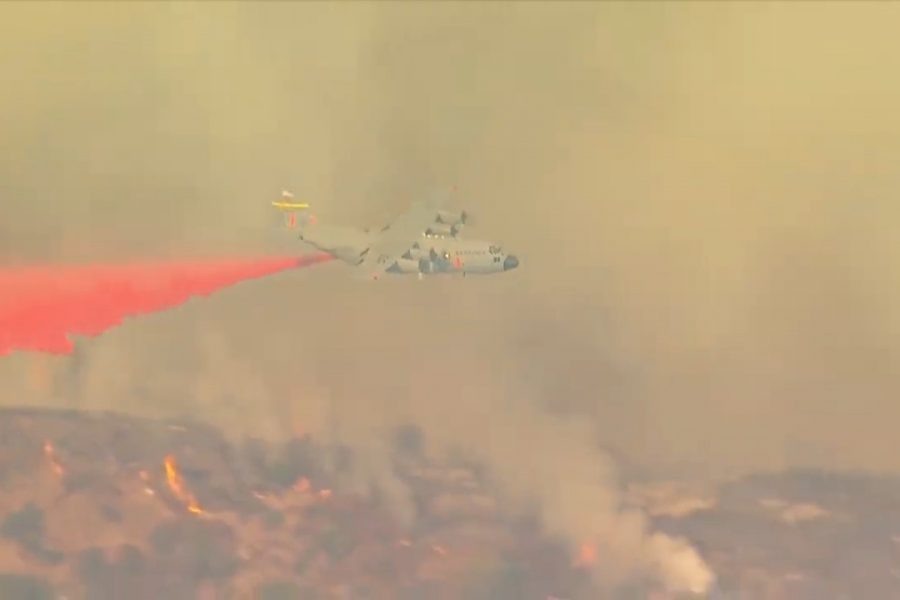Specially equipped Air National Guard and Air Force Reserve C-130s, outfitted with Modular Airborne Fire Fighting Systems, are back on duty fighting wildfires rampaging across California after a year off because of a slow season.
Four USAF airlift wings carry MAFFS—a roll-on, roll-off system with a massive 3,000-gallon tank that shoots fire retardant out of the rear parachute door of the Hercules. As of Aug. 21, four of those aircraft are flying daily, fighting more than 360 fires across California. Two C-130s from the California Air National Guard’s 146th Airlift Wing at Channel Islands Air National Guard Station are fighting fires within the unit’s own backyard in Southern California, while two C-130s from the Wyoming Air National Guard’s 153rd Airlift Wing are deployed to Sacramento to fight a series of complex fires in Northern California. Seventy-nine personnel are activated in total. Within the next week, C-130s from both the Nevada Air National Guard’s 152nd Airlift Wing and the Air Force Reserve’s 302nd Airlift Wing will rotate in to provide relief for the crews.
“It’s ramped up in intensity within the last week,” said Col. Gregory Berry, commander of the 302nd Air Expeditionary Group, who is coordinating the response.
On Aug. 19, C-130s flew 23 sorties, totaling 21 drops, focusing on the massive LNU Lightning Complex fire near Vacaville. Just six or seven days before, all MAFFS aircraft were focusing on Southern California, before a massive lightning storm moved through Northern California, sparking a large number of fires. “If you asked me last week what we’d do, I would’ve guessed SoCal,” Berry said. “The need has moved.”
According to CalFire, over seven days ending Aug. 21 fires burned more than 1,200 square miles in the state. There were 560 total fires burning, with more than 10,000 firefighters on duty. As of Aug. 20, six people were killed and more than 30 injured, and more than 50,000 structures were threatened with 175 destroyed, according to the agency.
Since deploying in mid-July, the C-130s have flown a total of 156 sorties totaling 194.9 hours. They have conducted 144 drops of 394,666 gallons or 3,540,154.6 pounds of retardant as of Aug. 20.
The C-130s are activated by 1st Air Force (Air Forces Northern) in response to Defense Department approval of a U.S. Forest Service request—the agency that actually owns the firefighting system. The rest of the year, the C-130s are regular Air National Guard and Air Force Reserve planes.
Every day, an incident commander on the ground fighting the fires calls for aviation assistance, and that request goes into an area coordination center that tasks out aircraft—similar to how a combined air operations center builds an air tasking order for combat operations. The MAFFS C-130s are “one piece of the air puzzle,” with other aircraft such as CalFire’s own fleet or contractor aircraft also available.
“It’s a very organized system, a mix of different assets,” Berry said.
For example, on Aug. 22 two aircraft were exclusively targeting the LNU fire. Once they arrived on sight, they worked with a lead plane and crews on the ground for where to drop the retardant.
The liquid, a pink chemical “slurry” instead of water, is dropped not on the fire itself, but instead ahead of the fire line so the flames don’t have fuel to move further and give those on the ground space to work. The aircraft are able to drop into terrain that ground crews can’t move to and get hard to reach areas, Berry said.
MAFFS units bring in “extremely experienced” aircrews to fly the missions, since dropping on fires is difficult. For example, a C-130 might have to fly 120 knots at 150 feet off the ground, “slow and very heavy,” on the leading edge of a fire with smoke and heat turbulence, and poor visibility to boot, Berry said. Pilots need to be formation air dropped qualified, and usually have years of experience before entering the program.
The crews train every spring with other firefighting crews in mountainous areas to prepare for fire season.
The California units fly the newer J-models, and deploy with a crew of four. This season, it is personal for this wing because the fires are so close, Berry said.
“It is literally their back yard,” he said. “It’s 100 percent personal. We are all passionate about it.” Flying in your own town “brings on a personal element” and a drive to “get that thing to bed,” he said.
The other units fly the older H-model, and deploy with an aircrew of six plus the maintenance element. For Berry’s home unit, the 302nd Airlift Wing, the unit had their major personal fight with the 2012 Waldo Canyon fire that burned more than 18,000 acres near their home base.
“That one was absolutely personal. We’re honored to be part of the solution again and get that thing to bed,” Berry said, “We want to help Americans, period.”
Flying MAFFS airdrops can be instantly gratifying for crews, seeing the retardant save a house or make things easier for ground crews in “horrific conditions,” Berry said.
“We’re passionate about this mission,” he said. “Arguably the most rewarding thing we can do is to help fellow Americans in their time of need.”
Editor’s Note: This story was updated at 9:12 a.m. on Aug. 24 to reflect the Reserve affiliation of the 302nd Airlift Wing.

